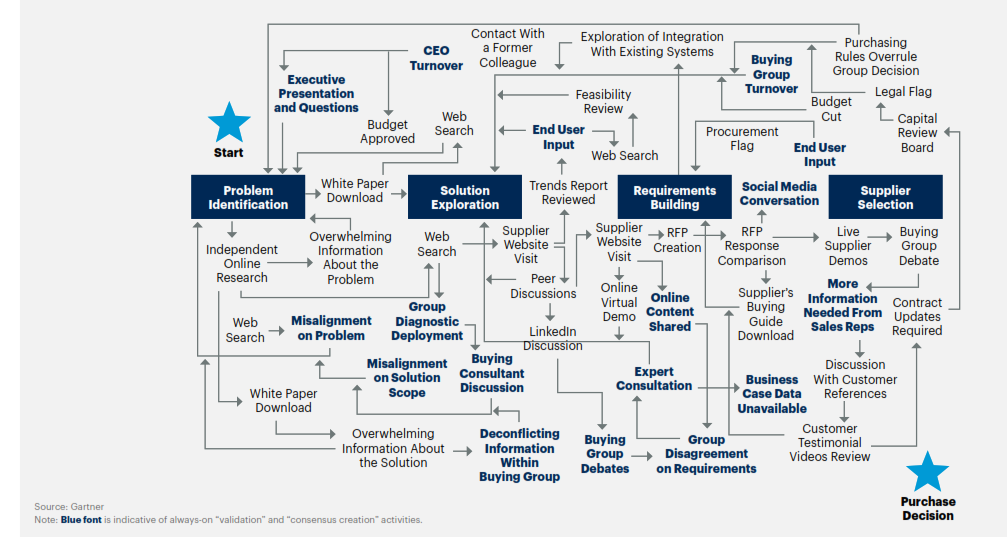 In 2020, the pandemic caused a dramatic shift in behavior among B2B buyers, as face-to-face meetings, in-person events, and traditional workplaces came to a halt. Digital channels became the only way to engage with prospects and customers. Buyers consumed top-of-funnel assets – short overview pieces like blog posts, brochures, infographics, and short videos. How has B2B content consumption changed over the past year?
In 2020, the pandemic caused a dramatic shift in behavior among B2B buyers, as face-to-face meetings, in-person events, and traditional workplaces came to a halt. Digital channels became the only way to engage with prospects and customers. Buyers consumed top-of-funnel assets – short overview pieces like blog posts, brochures, infographics, and short videos. How has B2B content consumption changed over the past year?
State-of-the-Market
Consider these recent statistics:
- In a recent survey by the CMO Council, 87% of B2B buyers said that content had had a major or moderate impact on vendor selection. The top four reasons are:
-
- Identifies new approaches to problems
- Introduces fresh thought leadership on issues
- Validates the value of products and solutions
- Highlights companies who understand customer issue
- The rule of seven states that prospective buyers need to hear or see your message at least seven times before they buy it from you. Edelman Trust Barometer found that 63% of consumers need to hear company claims three to five times before they believe them.
- B2B buyers report spending exceedingly little time with sales reps. Only 17% of the total purchase journey is spent with sales reps. 44% of Millennials prefer no sales rep interaction in a B2B purchase setting (Gartner)
"We are witnessing a decided end to the era where sales reps were the channel; now they are merely a channel to customers." - Gartner
The B2B Buyer's Journey
The buyer's journey is becoming increasingly complex. According to Gartner, the number of individual stakeholders involved in a complex B2B purchase is between 11 and 20, and the buying journey is a complex, nonlinear path. Look at the number of opportunities to supply content during the journey.

B2B Content Consumption Changed in 2021
According to a new report from intelligent content platform provider PathFactory, B2B content consumption significantly increased during 2021 compared to the previous year. There was a 54.5% increase in the total number of visitors, 35.7% more sessions, 34.5% more page views, and 42.7% more unique asset views of B2B content.
Marketers added 1.3X more content to their libraries in 2021 than in 2020, especially videos, blogs, and webinars, while shorter assets like brochures and data sheets took a backseat. Production costs increased, averaging $2,791 per asset compared to $2,411 the previous year.
Content types with the highest average view times included whitepapers, webcast recordings, and surveys. However, visitors across the board engaged with a mix of short- and long-form assets. This indicates that content journeys continue to be complex and nonlinear and that topics of interest matter more to visitors than the actual format.
What does this mean for you?
Here is a four-step plan to get you ready for 2022.
- Conduct a messaging review. Do your messages still resonate with buyers? Does your market positioning still work? Are your vision and thought leadership ideas fresh? What are your competitors saying? This is very important. Your competitors can completely change their messaging without you realizing it. Many markets fragmented during the pandemic, and companies responded by repositioning. Your brand and message are not static, and your industry and company are dynamic. It is important to conduct an in-depth review of your messaging every year.
- Conduct a content audit to see what you have and identify gaps. Identify any outdated content and prioritize it for updating.
- Take a good look at your middle of funnel (MOF) content – content that addresses the consideration stage. This type of content is where buyers begin the selection process. Buyers want to know that you understand their challenges and know how to solve them. Many companies do a good job at Top-of Funnel content but fail to develop more in-depth information. MOF content is hard to develop, requires a subject matter expert, and costs more to develop.
- Align content with your buyer's touchpoints. Deliver what they need, when they need it.
Do you need help reviewing messaging, conducting a content audit, or developing high-quality MOF content? Sign up below for a free assessment.




